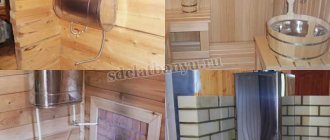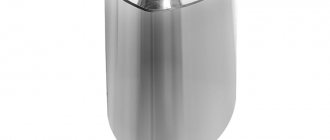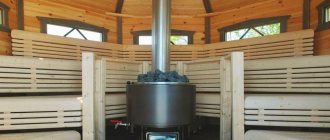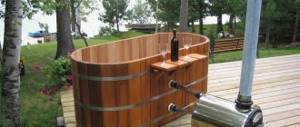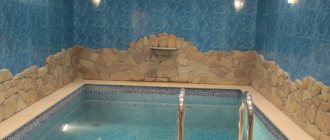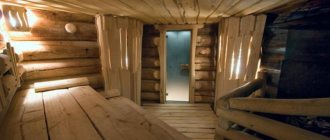What to do
- If the design of the storage tank does not provide outlets or the location of the pipes does not correspond to the selected connection diagram (for non-standard piping), you need to cut holes: for the supply pipe, outflow pipe and overflow pipe. The first can be installed at any level, since water flows into the tank under pressure when it is filled (but better in the upper part of the tank). The second is about 10 cm above the bottom, so that settled turbidity (sand, silt, dust) does not enter the system. The holes for the overflow pipe are prepared 2–3 cm below the installation site of the float valve; if it does not react, excess water will not spill out of the tank onto the floor or area. To properly maintain the storage tank, you will have to drain the water completely. Therefore, one more inspection hole is needed (in the lower part of the tank).
- Organize natural ventilation. To do this, a cutout is made in the lid of the storage tank to prevent debris from getting inside the tank. A mesh alone is not enough - it will not prevent dust from entering.
- Install the float switch. When the tank is filled, it will give a command to turn off the pumping device, and when the water level is low, to turn it on.
- Cleaning filter. It is placed at the entrance to the storage tank and protects it from sediment from the main line (sand, rust, salt deposits).
To protect the pump from operation in “dry running” mode, you need to install an appropriate relay if the design of the pump does not provide for this element of automation.
When installing the tank yourself, you can use one pipe to fill it and supply water to the house. You just need to install shut-off valves and switch valves in a timely manner.
General information about plastic water tanks
Material of manufacture
The main components are polyethylene and polypropylene. These two materials have different characteristics, and accordingly, products are manufactured with different features and functionality.
Standard water containers are made of thermoplastic polyethylene. It has average resistance to high temperatures, insulating ability and resistance to mechanical damage, including impacts. Tanks can be used to store and transport water.
Each type of polypropylene is responsible for certain product qualities:
Impact resistance- Resistance to chemicals
- Working with low temperatures
- UV protection
- Good tolerance to high temperatures, etc.
Attention! If you need a plastic tank for drinking water, you should purchase a product made of food-grade polymer with a special protective film.
The tanks are manufactured using the rotational method.
The shape of the product is attached to a special axis (there can be one or two axis, if there are two, then they rotate in different directions), the polymer is heated to a liquid state and the blank is lowered and, as it were, wraps the material around itself.
Once the rotational casting process is complete, the product is allowed to cool and harden.
This creates a container with uniform wall thickness and no seams.
Advantages of plastic containers
- Absolute tightness. The tanks are monolithic, there are no connecting seams - this is a guarantee of impermeability.
- Easy installation. The products are lightweight, making them easy to transport and install.
- High resistance to chemicals. Plastic does not react to aggressive compounds, which allows you to store water without allowing changes in the chemical composition and taste.
- Long service life - up to 50 years.
- Heat resistance. Plastic products do not change their properties at temperatures from -40 to +50 degrees Celsius.
- Easy care. You can wash the tank with any detergent.
Important! Standard plastic tanks are not high-strength products. If you need the most durable tank, give preference to models with thick walls, complemented by special ribs to increase rigidity.
Types of containers
The tanks are available in two colors - black and blue.
The black tank is used for storing water outdoors.
The blue tank is designed to hold liquid indoors.
Black containers heat up well in the sun, providing warm water, while not allowing sunlight to pass through, which preserves the chemical properties of the liquid.
Basic forms of tanks
Rectangular products. Used for underground and above ground storage. The correct shape allows for rational use of space and transportation of several tanks at the same time.- Cylindrical tanks are installed above ground. The water stored in them is used for domestic needs.
- Tanks in the form of a cone. Most of them are purchased to organize a shower.
Main groups of tanks
- For storing drinking liquid. The drive is cast from food-grade polymer. Guarantees protection against bacteria and harmful substances. Retains water without changing the chemical composition. Some models have a float and valve in their design for convenient liquid intake.
- For containing technical fluids. The scope of application is huge. They are installed as septic tanks, used for arranging a sewer system, in agriculture, for collecting and storing precipitation and wastewater, for creating irrigation systems or summer showers, as storage tanks and autonomous systems.
For your information. Drinking water is stored in containers, the vast majority of which are intended for above-ground installation indoors.
Technical tanks can be installed both on the ground and underground, indoors and outdoors.
Service
Maintenance of the storage tank is recommended to be carried out annually. If the quality of water from the reservoir has noticeably deteriorated, more often, as necessary. The main technological activities are:
- visual inspection of the tank, suitable lines, metal structures (when installing the tank on a support). Based on the diagnostic results, a list of necessary work is determined;
- cleaning the tank. The walls of the storage tanks are smooth, and therefore all the turbidity accumulates at the bottom. The process of removing it is quite simple: the inspection hatch is opened, the water is completely drained, along with the dirt. For high-quality cleaning, it is advisable to pour the entire container thoroughly (under pressure) through the top hatch for 10–15 minutes (to remove remaining deposits) until clean water appears;
- disinfection. The contents of the tank are not completely consumed, so stagnation of some of the liquid is inevitable. This initiates the development of pathogens, from which the storage container should be disposed of. A small amount of water is poured into it for 2-3 hours, to which chlorine bleach is added (as an option). After such exposure, you can begin to work: “wet” cleaning of the walls and bottom is carried out using brushes and scrapers with an extended handle. At the end of the procedure, the tank is emptied and washed several times with running water.
Scrapers and brushes should not leave scratches on the walls. These are potential areas where sediment accumulates and microorganisms grow. The cavity of the tank must be cleaned very carefully.
A complete list of maintenance work for a specific version of the water tank is indicated in the accompanying documentation for the product.
Types of expansion tanks
An open-type tank can be with or without a lid; the liquid level here is constantly changing due to evaporation and temperature expansion.
The coolant must be added periodically, but so that there is no overflow.
Open tanks are usually used where water moves through pipes by gravity. This is a gravitational system based on the property of hot coolant to move upward.
Closed tanks are installed where the circulation pump is used. In turn, it can be:
Design of a membrane expansion tank for a heating system: in a sealed container there are two chambers (one above the other), separated by a rubber membrane. At the bottom there is a pipe for connecting the heating system.
Valtec 24-liter membrane expansion tank
An increasing volume of liquid comes from it. The pressure increases, the membrane bends, letting in more and more liquid. The upper chamber is filled with air. It is necessary to compensate for the expansion of water, but is completely unnecessary for heating, which is why rubber is needed to reliably protect the pipes from air pockets getting into them.
The balloon design is distinguished by the fact that a rubber membrane is located around the perimeter of the entire tank and is attached like a bag to the inlet pipe. The coolant does not come into contact with any part of it (which increases the service life of the container).
Repair
Small leaks in the tank can be easily repaired on your own. These are typical malfunctions that manifest themselves mainly in the places where the pipes exit and where they connect with the pipes. You won’t need a welding machine, especially for plastic tanks. When eliminating defects yourself, it is recommended to use special putties and adhesives. The nuance is that not every product is suitable for these purposes - we are talking about water, which is also used for drinking and cooking.
When choosing a composition, you need to carefully read the instructions for its use. Experts recommend eliminating leaks in storage tanks using “cold welding”, two-component glue (“Poxypol”) or similar properties. To increase reliability, after applying the first layer, you need to apply a patch (for example, a piece of gauze) to the damaged area and re-process it. Manufacturers always indicate means that can be used to eliminate minor defects in the tank body; you just need to carefully read the instructions.
You need a quality water storage tank. Don’t waste time searching - the website alfatep.ru presents various versions of tanks from well-known manufacturers at factory prices. Our online store also has everything necessary for their installation: pipes, shut-off valves, fittings, sealants. ALFATEP employees will help with calculations of the required tank capacity and recommend the optimal model, advise on the procedure for servicing and repairing the product, and advise which materials should be used. You can ask questions through the “Contacts” option or by phone (calls within the Russian Federation are free). Delivery of containers to the customer is carried out by the company’s representative offices in the regions, in a short time; We work all over Russia. Form of payment – at the client’s choice, it is possible to provide a loan on preferential terms.
Water tanks in irrigation systems
Water storage in tanks can play an important role in irrigation systems. The fact is that heating water is best done naturally. Therefore, when purchasing water tanks, your choice should be in favor of dark-colored tanks. In the sun, the water in them warms up faster, and the problem of water blooms will no longer bother you, since the sun's rays do not pass into the tank through the dark walls. We have a separate section of the website about the use of water tanks. There you will learn what components a water storage tank consists of, as well as how to choose the right equipment. If you are hesitant about choosing equipment based on their characteristics, our consultants will answer all questions and recommend the necessary equipment.
Option No. 2: installing a water tank in the basement
The advantages of the second option of installing a storage tank in the basement are undeniable:
- ease of access to the container facilitates its maintenance;
- using an additional pump in the water supply system, you can create the required water pressure;
- installation of the tank does not require the use of additional design solutions to strengthen the base under the tank.
There is only one drawback, but a significant one: if the electricity in the house goes out, the water supply will not function. Considering that this problem is solved by the presence of an emergency power source, for example, a generator based on an internal combustion engine, the second option of installing a storage tank in houses with a basement is clearly preferable.
If the well is acting up
Sometimes problems arise with an artesian well over time: the flow rate decreases, the quality of the water deteriorates, or the sand content in it increases. To determine the causes of the “disease,” a television inspection can be performed. This is done using a special camera lowered into the water and filming on videotape the condition of the internal walls of the water-lifting pipe along its entire length (well logging). Subsequent careful viewing of the videotape will reveal the reasons for the deterioration of the well's performance. There may be several of them. For example, partial destruction of the production casing filter, the appearance of a hydraulic connection between the aquifer and the layers of rock located above it, mechanical damage to the wall, disruption of the connection of individual sections of the casing or production string, depressurization of the casing pipe, a sharp increase in the number of wells in the area, etc. Experts believe that the results of telelogging, which will cost from $3 per 1 m of length, will not only help decide whether to repair an existing well or drill a new one, but will also reduce the decision-making time to one day. The costs of eliminating the causes of deterioration in well performance will also be reduced. Collecting rainwater from roofs
Peak water loads in central Russia occur annually from May to August, when the moisture consumption for irrigation far exceeds the amount of natural precipitation. During this period, lovers of lush green areas can compensate for periodic water shortages with the help of a storage tank. On the contrary, during the rainy season, which lasts from the end of August to November, excess natural moisture can be collected and used for household needs in the same year. Rainwater is guaranteed to be soft and can be successfully used for washing and washing, but not for drinking - due to possible contamination with sulfur dioxide falling along with “acid” rain.
A special Hydrorain installation from GRUNDFOS with a capacity of 0.5 to 2 m3, a hydraulic accumulator tank and a pump automatically supplies the collected water to the addresses (toilet, washing machine, watering tap).
It is easy to install the device yourself in a place where rainwater is collected from the roof of a cottage, bathhouse and garage, connecting it with a flexible metal-plastic pipe to a seasonal water supply. A drainage moisture collection system (for example, from the German company INEFA-KUNSTSTOFFE) will itself purify the water from fallen leaves. How much does a water supply system cost?
If you have a functioning well, all the necessary external water supply equipment, including a submersible pump from the SQ and SP model ranges (GRUNDFOS, Denmark), USD (CALPEDA, Italy), UPA (KSB, Germany), SCM (NOCCHI, Italy) or BHS (EBARA, Japan) - their characteristics were given in the article “A spring on your site”, as well as its installation, control systems, head, caisson, hatch, insulating cushion, hydraulic accumulator tank, controller, main pipe up to 100 m long, laid below freezing depths, together with excavation work, transportation costs and a one-year warranty will cost you $2.5-7 thousand. The last figure is related to the supply of water to separate buildings: a garage, a bathhouse, a swimming pool.
Connecting a seasonal branch can cost another $0.6-1.5 thousand (depending on the size of the container and the length of the pipes). The purchase of a device for collecting rainwater, which completes the creation of the external part of the water supply system, if connected to the system independently, will cost an additional $1.2 thousand or more. The cost of the interior plumbing is not considered because it usually includes the amount spent on plumbing products. Maintenance of the water supply system
Particles of sand and silt contained in water can lead to wear of the moving parts of the pump, form deposits on the internal surfaces of horizontally located pipes, and particles of iron, manganese, lime compounds and bacteria can also form in the cracks of the well filter and in the intake part of the pump . The ingress of corrosive carbon dioxide, salts or copper ions with water contributes to the corrosion of water supply elements, especially at joints, as a result of which the tightness is broken. Voltage surges over time can damage the insulation of the pump motor windings.
That is why once every 5-6 years the entire system must be comprehensively inspected by a specialist. The inspection may reveal the need to replace gaskets, fittings or individual sections of pipes, and even repair the submersible pump. Data received from the controller will help determine the inspection period.
With the onset of cold weather, it is enough to install an insulating foam pad 20-30 mm thick into the caisson at a depth of about 1 m from the hatch. This structure, mounted on a wooden frame, will prevent the temperature of the well head with the valve from falling below +4°C even in particularly severe frosts. Water from the container and from the seasonal water supply intended for irrigation must be drained before the onset of cold weather by simply opening the taps.
It is very convenient to supply an autonomous water supply system for maintenance, which will cost 8-10% of the cost of the equipment annually.
The experience of the installation and service company that carries out such maintenance shows that a diagnostic inspection of the water supply system twice a year with free replacement of the necessary elements completely eliminates the occurrence of emergency situations. If the power supply is cut off
The assembled system works flawlessly as long as all the pumps included in it are powered by electricity. What if the power supply is turned off? There are two possible ways out of this situation. The first involves connecting to an autonomous energy source, usually an electric generator running on gasoline or diesel fuel. The second solution is simpler, but not always feasible: it involves switching to rural water supply. Although it is often not reliable, you should not refuse the possibility of such a connection (even after installing an autonomous water supply system). When the power supply is de-energized, you only need to “transfer” the system with a valve to operate from another water source.
Some practical recommendations
- When developing a water supply diagram, think through its possible changes in the future in as much detail as possible. Let the construction and installation organization take into account these wishes of yours when designing, then it will be possible to increase the length of pipes or the number of consumers without disturbing the specified fluctuations in water pressure in the pipes.
- Grounding and lightning protection of the water supply system must be carried out very carefully so that the rather sensitive electronic control circuit is not damaged as a result of a possible lightning strike.
- With a cheaper nightly electricity tariff, the use of additional containers will not only solve the problem of water shortages, but will also allow you to save money by storing it at night.
- It should be noted that the construction and installation organization provides a guarantee only when completing the water supply system with fittings (compression or collet clamps, fittings, water level limiters, valves) that it offered itself, and not that the customer bought.
- When the pump operates not from the electrical network, but from another source, it is advisable to save energy to supply water from the well first into a storage tank, and then, by gravity or force, into the water supply system.
- In order to maintain the speed of water sucked in by a submersible pump at the level of 0.15 m/s in case of insufficient flow of the well (this is necessary for normal cooling of the electric motor), you can equip the pump with a water receiving chamber, mounted when lowering the pump to artificially increase the speed of water at the suction point.
- A sand concentration in water from an artesian well exceeding 15 mg/l will not only dramatically increase pipe wear, but will also necessitate frequent backwashing of filters. Otherwise, the service life of the well itself will be shortened. And although the permissible limit of this concentration for most models of submersible pumps is 3 times higher, the cause of the growth of suspended matter in the water should be identified as soon as possible, for example, using telelogging.
The editors would like to thank F-PLAST, BIIX, ANION, ROLS ISOMARKET, EGOPLAST, GRIF, SANTEKHKOMPLEKT, installation and service and the representative office of GRUNDFOS for their assistance in preparing the material.
